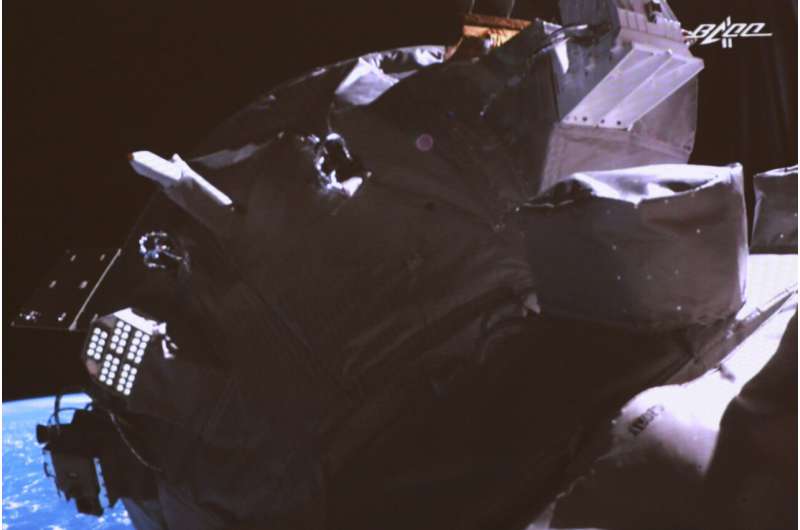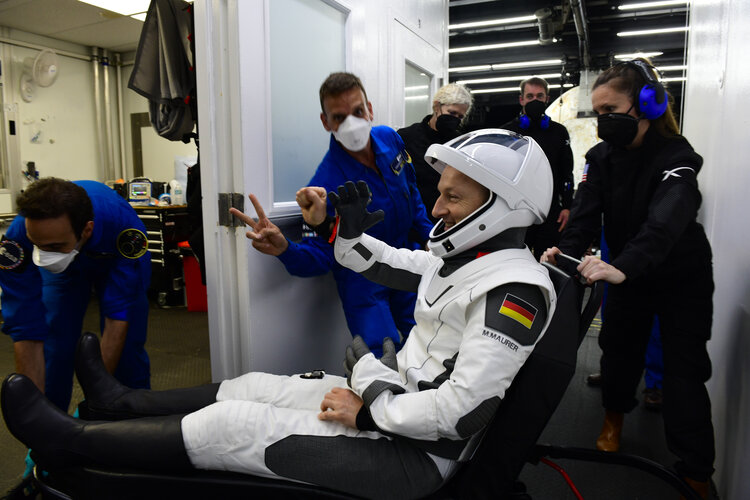Supplies launched to China's new space station for next crew
Tuesday, 10 May 2022 06:44
Watch live: press conference with Matthias Maurer back on Earth
Tuesday, 10 May 2022 06:30
ESA astronaut Matthias Maurer is back in Europe after 177 days in space. Watch the first press conference following his Cosmic Kiss mission at 11:45 CEST (10:45 BST) 11 May live on ESA Web TV.
Canada joins U.S. in ASAT testing ban
Tuesday, 10 May 2022 01:34
The Canadian government announced May 9 that it is joining the United States in banning tests of destructive direct-ascent antisatellite weapons as a step toward norms of responsible behavior in space.
The post Canada joins U.S.
MIRI's sharper view hints at new possibilities for science
Tuesday, 10 May 2022 01:10
Paris (ESA) May 10, 2022
 The James Webb Space Telescope is aligned across all four of its science instruments, as seen in a previous engineering image showing the observatory's full field of view. Now, we take a closer look at that same image, focusing on Webb's coldest instrument: the Mid-Infrared Instrument, or MIRI.
The MIRI test image (at 7.7 microns) shows part of the Large Magellanic Cloud. This small satell
The James Webb Space Telescope is aligned across all four of its science instruments, as seen in a previous engineering image showing the observatory's full field of view. Now, we take a closer look at that same image, focusing on Webb's coldest instrument: the Mid-Infrared Instrument, or MIRI.
The MIRI test image (at 7.7 microns) shows part of the Large Magellanic Cloud. This small satell
 The James Webb Space Telescope is aligned across all four of its science instruments, as seen in a previous engineering image showing the observatory's full field of view. Now, we take a closer look at that same image, focusing on Webb's coldest instrument: the Mid-Infrared Instrument, or MIRI.
The MIRI test image (at 7.7 microns) shows part of the Large Magellanic Cloud. This small satell
The James Webb Space Telescope is aligned across all four of its science instruments, as seen in a previous engineering image showing the observatory's full field of view. Now, we take a closer look at that same image, focusing on Webb's coldest instrument: the Mid-Infrared Instrument, or MIRI.
The MIRI test image (at 7.7 microns) shows part of the Large Magellanic Cloud. This small satell Virgin Orbit announces next launch, dubbed 'Straight Up'
Tuesday, 10 May 2022 01:10
Long Beach CA (SPX) May 10, 2022
 Virgin Orbit (Nasdaq: VORB) has entered flight preparation mode for its forthcoming launch, Straight Up, that will support the United States Space Force's STP-28A mission. After departing Virgin Orbit's Long Beach rocket factory on Thursday, April 28, 2022, the rocket arrived at the Mojave Air and Space Port. It will support the Rocket Systems Launch Program (RSLP) and will carry payloads for th
Virgin Orbit (Nasdaq: VORB) has entered flight preparation mode for its forthcoming launch, Straight Up, that will support the United States Space Force's STP-28A mission. After departing Virgin Orbit's Long Beach rocket factory on Thursday, April 28, 2022, the rocket arrived at the Mojave Air and Space Port. It will support the Rocket Systems Launch Program (RSLP) and will carry payloads for th
 Virgin Orbit (Nasdaq: VORB) has entered flight preparation mode for its forthcoming launch, Straight Up, that will support the United States Space Force's STP-28A mission. After departing Virgin Orbit's Long Beach rocket factory on Thursday, April 28, 2022, the rocket arrived at the Mojave Air and Space Port. It will support the Rocket Systems Launch Program (RSLP) and will carry payloads for th
Virgin Orbit (Nasdaq: VORB) has entered flight preparation mode for its forthcoming launch, Straight Up, that will support the United States Space Force's STP-28A mission. After departing Virgin Orbit's Long Beach rocket factory on Thursday, April 28, 2022, the rocket arrived at the Mojave Air and Space Port. It will support the Rocket Systems Launch Program (RSLP) and will carry payloads for th Roscosmos boss calls to hold Elon Musk 'accountable' for supporting Ukraine 'fascists'
Tuesday, 10 May 2022 01:10
Washington DC (UPI) May 10, 2022
 Elon Musk has responded after Dmitry Rogozin, the head of Russia's federal space agency Roscosmos, sent a message to Russian media accusing him of supporting "fascist forces" in Ukraine.
The accusation by Rogozin, shared to Twitter by Musk, comes after the chief executive of SpaceX sent user terminals for its Starlink satellite-internet system to Ukraine in February at the request of offic
Elon Musk has responded after Dmitry Rogozin, the head of Russia's federal space agency Roscosmos, sent a message to Russian media accusing him of supporting "fascist forces" in Ukraine.
The accusation by Rogozin, shared to Twitter by Musk, comes after the chief executive of SpaceX sent user terminals for its Starlink satellite-internet system to Ukraine in February at the request of offic
 Elon Musk has responded after Dmitry Rogozin, the head of Russia's federal space agency Roscosmos, sent a message to Russian media accusing him of supporting "fascist forces" in Ukraine.
The accusation by Rogozin, shared to Twitter by Musk, comes after the chief executive of SpaceX sent user terminals for its Starlink satellite-internet system to Ukraine in February at the request of offic
Elon Musk has responded after Dmitry Rogozin, the head of Russia's federal space agency Roscosmos, sent a message to Russian media accusing him of supporting "fascist forces" in Ukraine.
The accusation by Rogozin, shared to Twitter by Musk, comes after the chief executive of SpaceX sent user terminals for its Starlink satellite-internet system to Ukraine in February at the request of offic DLR Land Down Under
Tuesday, 10 May 2022 01:10
Adelaide, Australia (SPX) May 10, 2022
 In preparation for their ReFEx rocket launch campaign from Australia, the DLR team are visiting spaceport partner Southern Launch. As part of their visit, the DLR team will be visiting Southern Launch's spaceports; the Whalers Way Orbital Launch Complex and the Koonibba Test Range, as well as meeting with key personnel across the Australian space industry.
DLR is the Federal Republic of Ge
In preparation for their ReFEx rocket launch campaign from Australia, the DLR team are visiting spaceport partner Southern Launch. As part of their visit, the DLR team will be visiting Southern Launch's spaceports; the Whalers Way Orbital Launch Complex and the Koonibba Test Range, as well as meeting with key personnel across the Australian space industry.
DLR is the Federal Republic of Ge
 In preparation for their ReFEx rocket launch campaign from Australia, the DLR team are visiting spaceport partner Southern Launch. As part of their visit, the DLR team will be visiting Southern Launch's spaceports; the Whalers Way Orbital Launch Complex and the Koonibba Test Range, as well as meeting with key personnel across the Australian space industry.
DLR is the Federal Republic of Ge
In preparation for their ReFEx rocket launch campaign from Australia, the DLR team are visiting spaceport partner Southern Launch. As part of their visit, the DLR team will be visiting Southern Launch's spaceports; the Whalers Way Orbital Launch Complex and the Koonibba Test Range, as well as meeting with key personnel across the Australian space industry.
DLR is the Federal Republic of Ge Phantom Space places order for more than 200 Ursa Major rocket engines
Tuesday, 10 May 2022 01:10
Tucson AZ (SPX) May 10, 2022
 Phantom Space Corporation, a space applications company, has announced an agreement to purchase more than 200 rocket engines from Ursa Major, America's only independent pure-play rocket propulsion company. The order includes Ursa Major's 5,000-Pound Thrust Hadley engines and the new 50,000-pound thrust Ripley engines. By using Ursa Major's Hadley engines, Phantom's Daytona rocket is slated for o
Phantom Space Corporation, a space applications company, has announced an agreement to purchase more than 200 rocket engines from Ursa Major, America's only independent pure-play rocket propulsion company. The order includes Ursa Major's 5,000-Pound Thrust Hadley engines and the new 50,000-pound thrust Ripley engines. By using Ursa Major's Hadley engines, Phantom's Daytona rocket is slated for o
 Phantom Space Corporation, a space applications company, has announced an agreement to purchase more than 200 rocket engines from Ursa Major, America's only independent pure-play rocket propulsion company. The order includes Ursa Major's 5,000-Pound Thrust Hadley engines and the new 50,000-pound thrust Ripley engines. By using Ursa Major's Hadley engines, Phantom's Daytona rocket is slated for o
Phantom Space Corporation, a space applications company, has announced an agreement to purchase more than 200 rocket engines from Ursa Major, America's only independent pure-play rocket propulsion company. The order includes Ursa Major's 5,000-Pound Thrust Hadley engines and the new 50,000-pound thrust Ripley engines. By using Ursa Major's Hadley engines, Phantom's Daytona rocket is slated for o UK blogger detained in Baikonur confirms release from custody after issued fine
Tuesday, 10 May 2022 01:10
Moscow (Sputnik) May 10, 2022
 UK blogger Benjamin Rich, who was recently detained near a launch pad in the Baikonur spaceport, said on Sunday that the Russian police released him after questioning and handed out a fine.
On Saturday, Roscosmos chief Dmitry Rogozin said that UK citizen Benjamin Rich and a Belarusian citizen Alina Zelupa were detained during unauthorised passage near the 112 launch pad in Baikonur and tak
UK blogger Benjamin Rich, who was recently detained near a launch pad in the Baikonur spaceport, said on Sunday that the Russian police released him after questioning and handed out a fine.
On Saturday, Roscosmos chief Dmitry Rogozin said that UK citizen Benjamin Rich and a Belarusian citizen Alina Zelupa were detained during unauthorised passage near the 112 launch pad in Baikonur and tak
 UK blogger Benjamin Rich, who was recently detained near a launch pad in the Baikonur spaceport, said on Sunday that the Russian police released him after questioning and handed out a fine.
On Saturday, Roscosmos chief Dmitry Rogozin said that UK citizen Benjamin Rich and a Belarusian citizen Alina Zelupa were detained during unauthorised passage near the 112 launch pad in Baikonur and tak
UK blogger Benjamin Rich, who was recently detained near a launch pad in the Baikonur spaceport, said on Sunday that the Russian police released him after questioning and handed out a fine.
On Saturday, Roscosmos chief Dmitry Rogozin said that UK citizen Benjamin Rich and a Belarusian citizen Alina Zelupa were detained during unauthorised passage near the 112 launch pad in Baikonur and tak NASA's InSight Records Monster Quake on Mars
Tuesday, 10 May 2022 01:10
Pasadena CA (JPL) May 10, 2022
 NASA's InSight Mars lander has detected the largest quake ever observed on another planet: an estimated magnitude 5 temblor that occurred on May 4, 2022, the 1,222nd Martian day, or sol, of the mission. This adds to the catalog of more than 1,313 quakes InSight has detected since landing on Mars in November 2018. The largest previously recorded quake was an estimated magnitude 4.2 detected Aug.
NASA's InSight Mars lander has detected the largest quake ever observed on another planet: an estimated magnitude 5 temblor that occurred on May 4, 2022, the 1,222nd Martian day, or sol, of the mission. This adds to the catalog of more than 1,313 quakes InSight has detected since landing on Mars in November 2018. The largest previously recorded quake was an estimated magnitude 4.2 detected Aug.
 NASA's InSight Mars lander has detected the largest quake ever observed on another planet: an estimated magnitude 5 temblor that occurred on May 4, 2022, the 1,222nd Martian day, or sol, of the mission. This adds to the catalog of more than 1,313 quakes InSight has detected since landing on Mars in November 2018. The largest previously recorded quake was an estimated magnitude 4.2 detected Aug.
NASA's InSight Mars lander has detected the largest quake ever observed on another planet: an estimated magnitude 5 temblor that occurred on May 4, 2022, the 1,222nd Martian day, or sol, of the mission. This adds to the catalog of more than 1,313 quakes InSight has detected since landing on Mars in November 2018. The largest previously recorded quake was an estimated magnitude 4.2 detected Aug. Sliding Into the Weekend Like - Sols 3466-3468
Tuesday, 10 May 2022 01:10
Pasadena CA (JPL) May 10, 2022
 It's been a challenging week in Gale crater, but Curiosity and the rover team are ready to put those challenges behind us as we head into a busy weekend plan. I've been on shift as LTP and SOWG Chair this week, and we've had a handful of issues related to difficult terrain, being in a good orientation for communication, and having small downlink volumes available for planning.
Today was a
It's been a challenging week in Gale crater, but Curiosity and the rover team are ready to put those challenges behind us as we head into a busy weekend plan. I've been on shift as LTP and SOWG Chair this week, and we've had a handful of issues related to difficult terrain, being in a good orientation for communication, and having small downlink volumes available for planning.
Today was a
 It's been a challenging week in Gale crater, but Curiosity and the rover team are ready to put those challenges behind us as we head into a busy weekend plan. I've been on shift as LTP and SOWG Chair this week, and we've had a handful of issues related to difficult terrain, being in a good orientation for communication, and having small downlink volumes available for planning.
Today was a
It's been a challenging week in Gale crater, but Curiosity and the rover team are ready to put those challenges behind us as we head into a busy weekend plan. I've been on shift as LTP and SOWG Chair this week, and we've had a handful of issues related to difficult terrain, being in a good orientation for communication, and having small downlink volumes available for planning.
Today was a Rocket Lab launches BRO-6 for Unseenlabs
Tuesday, 10 May 2022 01:10
Rennes, France (SPX) May 10, 2022
 Unseenlabs, the European leader in radio frequency (RF) signals detection from space, successfully launched its seventh satellites dedicated to the geolocation of vessels at sea on may 3, with rocket lab launcher. In total, Unseenlabs has deployed seven satellites since 2019 and will launch other satellites in 2022.
Unseenlabs' constellation is designed to provide clients with data to foll
Unseenlabs, the European leader in radio frequency (RF) signals detection from space, successfully launched its seventh satellites dedicated to the geolocation of vessels at sea on may 3, with rocket lab launcher. In total, Unseenlabs has deployed seven satellites since 2019 and will launch other satellites in 2022.
Unseenlabs' constellation is designed to provide clients with data to foll
 Unseenlabs, the European leader in radio frequency (RF) signals detection from space, successfully launched its seventh satellites dedicated to the geolocation of vessels at sea on may 3, with rocket lab launcher. In total, Unseenlabs has deployed seven satellites since 2019 and will launch other satellites in 2022.
Unseenlabs' constellation is designed to provide clients with data to foll
Unseenlabs, the European leader in radio frequency (RF) signals detection from space, successfully launched its seventh satellites dedicated to the geolocation of vessels at sea on may 3, with rocket lab launcher. In total, Unseenlabs has deployed seven satellites since 2019 and will launch other satellites in 2022.
Unseenlabs' constellation is designed to provide clients with data to foll Plans unveiled to better connect space industries in Scotland and the UAE
Tuesday, 10 May 2022 01:10
Edinburgh UK (SPX) May 10, 2022
 Globally focused strategic space marketing firm AstroAgency, headquartered in Edinburgh, has announced it will team up with a Dubai-based space investment and advisory company AzurX, to support space businesses in both regions, access new development opportunities and forge collaborative partnerships.
The two organisations boast a global space client base, with AzurX acting as the trusted
Globally focused strategic space marketing firm AstroAgency, headquartered in Edinburgh, has announced it will team up with a Dubai-based space investment and advisory company AzurX, to support space businesses in both regions, access new development opportunities and forge collaborative partnerships.
The two organisations boast a global space client base, with AzurX acting as the trusted
 Globally focused strategic space marketing firm AstroAgency, headquartered in Edinburgh, has announced it will team up with a Dubai-based space investment and advisory company AzurX, to support space businesses in both regions, access new development opportunities and forge collaborative partnerships.
The two organisations boast a global space client base, with AzurX acting as the trusted
Globally focused strategic space marketing firm AstroAgency, headquartered in Edinburgh, has announced it will team up with a Dubai-based space investment and advisory company AzurX, to support space businesses in both regions, access new development opportunities and forge collaborative partnerships.
The two organisations boast a global space client base, with AzurX acting as the trusted China launches the Tianzhou 4 cargo spacecraft
Tuesday, 10 May 2022 01:10
Beijing (XNA) May 10, 2022
 In the latest stage in its space station program, China launched the Tianzhou 4 cargo spacecraft early on Tuesday morning, to transport fuel and supplies to its Tiangong space station, according to the China Manned Space Agency, or CMSA.
In a brief statement, the agency said that a Long March 7 carrier rocket blasted off from the Wenchang Space Launch Center in Hainan province at 01:56 am,
In the latest stage in its space station program, China launched the Tianzhou 4 cargo spacecraft early on Tuesday morning, to transport fuel and supplies to its Tiangong space station, according to the China Manned Space Agency, or CMSA.
In a brief statement, the agency said that a Long March 7 carrier rocket blasted off from the Wenchang Space Launch Center in Hainan province at 01:56 am,
 In the latest stage in its space station program, China launched the Tianzhou 4 cargo spacecraft early on Tuesday morning, to transport fuel and supplies to its Tiangong space station, according to the China Manned Space Agency, or CMSA.
In a brief statement, the agency said that a Long March 7 carrier rocket blasted off from the Wenchang Space Launch Center in Hainan province at 01:56 am,
In the latest stage in its space station program, China launched the Tianzhou 4 cargo spacecraft early on Tuesday morning, to transport fuel and supplies to its Tiangong space station, according to the China Manned Space Agency, or CMSA.
In a brief statement, the agency said that a Long March 7 carrier rocket blasted off from the Wenchang Space Launch Center in Hainan province at 01:56 am, JWST entering “home stretch” of commissioning
Tuesday, 10 May 2022 00:19
The James Webb Space Telescope is operating better than expected as the spacecraft enter the final stages of commissioning, project officials said May 9.
The post JWST entering “home stretch” of commissioning appeared first on SpaceNews.
